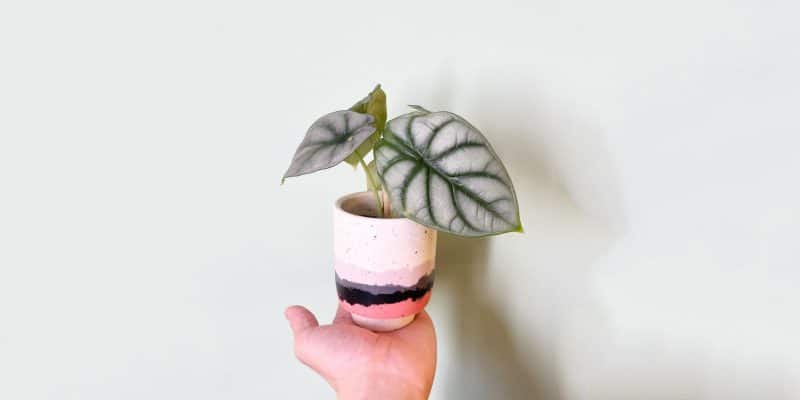You might think dragons only exist in fairy tales, but what if I told you there’s a mythical creature living right in your own home? No, I’m not talking about your adorable pet, but rather the captivating Alocasia Silver Dragon, also known as the African Silver Mask.
With its striking silver-green leaves and intricate patterns, this plant is sure to breathe new life into any space.
We’re going to dive right into the magical world of Alocasia Silver Dragon care — your guests will wonder if you’ve secretly become a plant wizard. You’ll learn all there is to know about this beautiful houseplant, from its origin story to its care requirements, and even how to troubleshoot when your scaly friend encounters a rough patch.
Don’t worry, caring for this plant isn’t as daunting as taming a fire-breathing dragon.
Table of Contents
Alocasia Silver Dragon Plant Care Guide
History, habitat, and characteristics
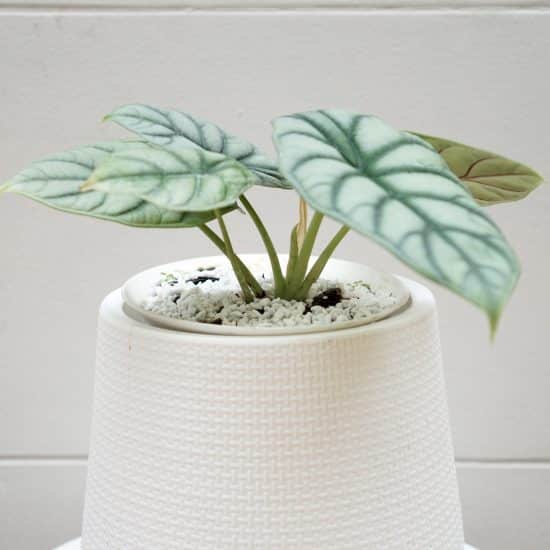
Alocasia Silver Dragon, or Alocasia baginda ‘Silver Dragon,’ is native to the lush rainforests of Southeast Asia. So, why’s everyone buzzing about this plant?
For one, it’s got lustrous, silvery leaves adorned with an intricate dragon scale-like pattern. As the plant grows, you’ll notice its gray hue becoming more prominent on older leaves. Plus, each leaf has its own unique variegation — small variations in color and pattern that make your Silver Dragon truly one of a kind.
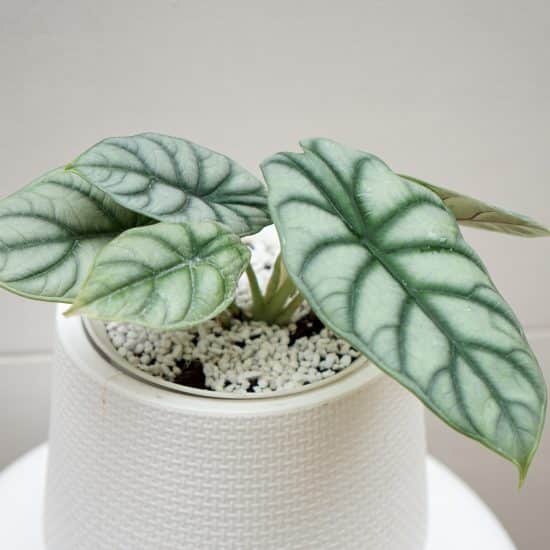
Fun fact: The name ‘Silver Dragon’ comes from the plant’s resemblance to dragon scales and its mystical silvery hue — an enchanting name that fits its enchanting personality.
Now, don’t let the exotic origin frighten you. This tropical beauty can thrive indoors given the right care and conditions that mimic its natural habitat. Think bright, indirect light, warm temperature, and high humidity — and your Silver Dragon will feel right at home.
Before we get into the full care guide for this plant, let’s take a brief look at a pretty special variety…
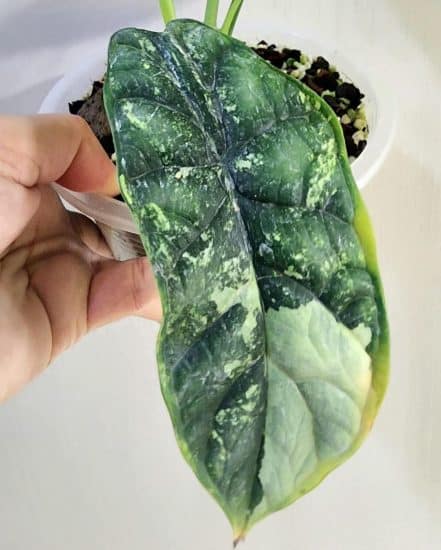
Alocasia Silver Dragon Variegata – For a while, these were equally exquisite and rare, but in the past year or so we’ve seen more become available as they’re propagated and prices have just begun to come down. The looks of the different variegated Alocasia Silver Dragon can vary, but they typically feature a pale green camouflage, with highlights of cream, white, and even dark greens that look almost black.
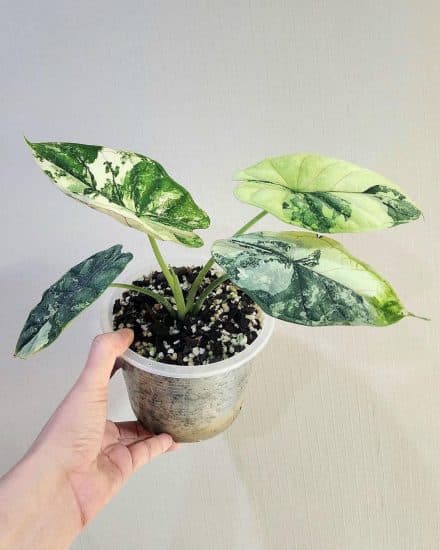
If you’re lucky enough to find one of these, do the world a favor and propagate a few more!
Light
Alocasia Silver Dragon plants will be happiest with indirect light and can even handle a smidge of dappled sun (think early morning or late afternoon rays). East- or north-facing windows are perfect for this plant.
Keep in mind, though, that harsh sunlight can burn its leaves, and not enough light can lead to leggy growth. To keep your silver dragon plant looking its best, you’ll want to protect it from intense sunlight or direct afternoon sun.
If Alocasia Silver Dragon isn’t getting enough light, you might notice slow, leggy growth and leaves reaching out for any available light. To fix this, try increasing the indirect light your plant gets, or consider adding an artificial light source.
On the flip side, if your plant’s soaking up too much direct sunlight, its leaves could become discolored or show signs of sun damage (like brown, scorched patches). In this case, it’s time to move your plant to a shadier spot or use a sheer curtain to filter that intense sunlight.
Water
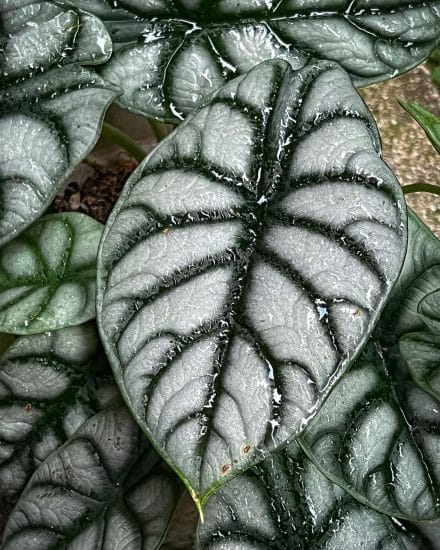
Let’s dive into how to strike that perfect balance between too little and too much water for a healthy Alocasia baginda Silver Dragon.
Alocasia Silver Dragon really prefers regularity and consistency with its watering schedule. If it’s in potting soil, aim for watering when the soil is almost dry. It can be hard to time this, so don’t be surprised if you let it dry out a bit too much the first few times.
So, what does not enough water look like? Watch out for those telltale crispy tips on the plant’s leaves. If you spot them, it’s time to up your watering game.
As for too much water, you’ll start seeing leaf spots, mushy stems, and wet soil. If that happens, take a step back and let the potting soil dry out before your next watering session.
One way to maintain consistent moisture levels is by placing your Alocasia in a semi-hydro setup in LECA. If you’re using regular potting soil, you can either increase the frequency of your watering schedule, make sure you’re giving your plant enough water (water should flow freely out of your pot’s drainage holes), or even consider bottom-watering in the future.
Temperature and humidity
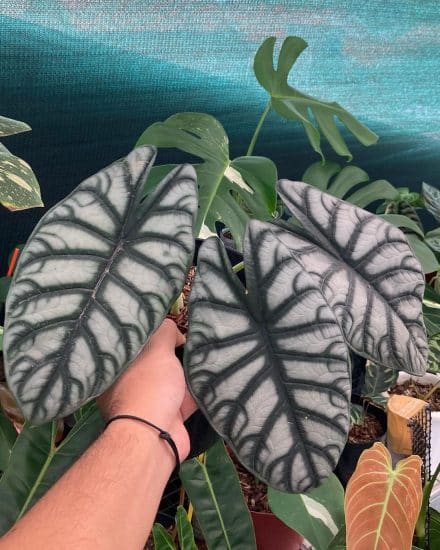
Caring for your Alocasia Silver Dragon means providing the right temperature and humidity levels to help it thrive.
Ideally, you should maintain temperatures between 55 and 80°F (13 and 27°Celsius) in a warm and humid place. If the temperature drops lower than this, the plant may enter dormancy.
Be especially cautious about cold drafts and avoid placing your plant near frequently opened windows or doors. Similarly, pay attention to any air conditioning units during the spring and summer months. These could make the environment too cold for your Alocasia Silver Dragon.
Watch out for signs of temperature stress. If your Alocasia Silver Dragon is dealing with temperatures that are too high or too low, you may see slowed growth, leaf curling, or wilting.
Alocasia Silver Dragon loves a moist environment, so aim for humidity levels around 60%-80%. If you find that the humidity in your home is too low, you can consider grouping tropical plants together, using a pebble tray filled with water, or adding a humidifier to increase moisture in the air.
Keep an eye out for signs of too much or too little humidity. If you notice the green foliage drooping or browning at the tips, this could be an indication that the humidity level is too low. Conversely, excessively high humidity may lead to issues like fungal and bacterial infections.
Soil and planting
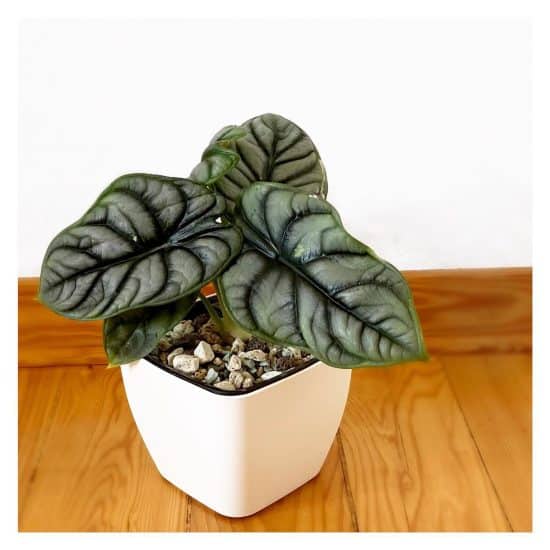
Alocasia Silver Dragon thrives in well-draining soil. To achieve adequate drainage, you can add bark, perlite, or pumice to a regular potting soil.
If your Alocasia Silver Dragon plant suffers from an unsuitable potting mix, you may notice stunted growth or wilting leaves. Signs of poor soil quality include waterlogged soil and a lack of new growth. If you notice these symptoms, consider replacing the soil and ensuring proper drainage to maintain your plant’s health.
When it’s time to repot your Silver Dragon, carefully clean the roots and corms before using a new soil mix composed of peat moss, organic matter, and garden compost. After repotting, water and rinse the plant thoroughly.
A combination of Superthrive vitamin solution and fertilizer can be used to boost the plant’s growth. Allow the plant to rest for a few days before returning it to its preferred spot, ideally near an east-facing window to provide it with (mostly indirect) natural light.
Alocasia Silver Dragon doesn’t require extensive pruning. However, you can remove dead leaves to maintain the plant’s striking foliage and promote healthier growth. Use sterilized shears or a sterile knife when pruning, and always cut back to the base of the leaf stem. This will ensure the plant continues to look its best while redirecting energy toward healthy growth.
Propagation
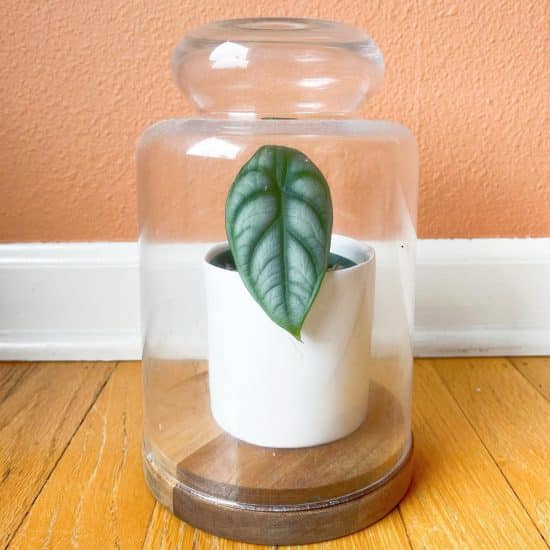
It’s no surprise that you might want to spread the plant love, so let’s get right into how to propagate Alocasia Silver Dragon. We’re going to use root clump division.
-
- Spot and separate those corms: First things first, you’ll need to check out the root system of your Alocasia Silver Dragon to find the small corms — those round, bulb-like buddies hiding among the roots. Once you spot them, carefully separate them from the parent plant using a clean, sterilized gardening tool. Remember to be gentle — we don’t want to hurt the healthy corms or plant roots in the process.
- Get your nursery cups and peat moss ready: Next up, grab some small nursery cups and fill them with moist sphagnum moss or a well-draining potting mix. These cozy little nests will provide the right support and moisture for your soon-to-be baby Dragons.
- Time to plant those separated corms or leaves with roots: Now, place the corms or small leaves with roots into the prepared nursery cups, making sure they’re snuggled in nicely with the moss or potting mix. Be mindful of overcrowding. We want to give each little one the chance to grow and thrive as a new plant.
- Keep an eye on moisture and growth: Finally, find a spot with bright light from an east- or north-facing window for your nursery cups, and make sure to maintain the right level of moisture in the moss or potting mix. Give your propagations a gentle check every now and then to ensure they’re not too wet. Excess water might lead to fungal and bacterial infections. A bit of patience is key here — it could be a few weeks before you see new growth emerging.
Our propagation tips:
- Remember to use sterilized gardening tools when separating corms. It’s proper plant-parenting hygiene to avoid any pesky pathogens or pests like spider mites.
- Don’t go overboard with watering those propagations. Too much love (in the form of water) can lead to unwanted algae or mold growth.
- Timing is everything! Propagate your Alocasia Silver Dragon during its growing season (spring or summer) for the best results. That’s when your plant has the most energy to focus on bringing new baby Dragons into the world.
Common issues
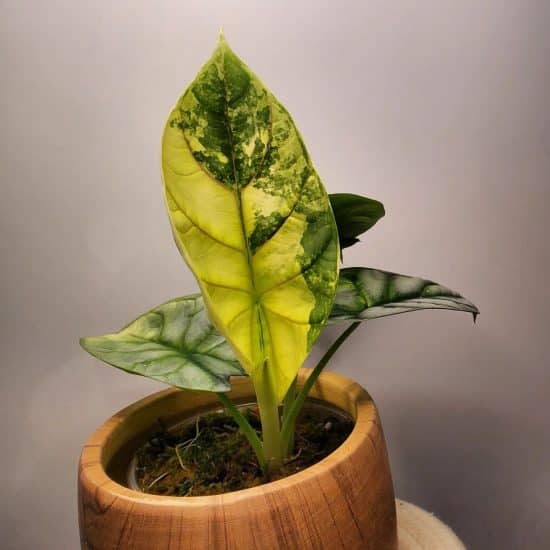
Even a well-cared-for indoor plant can have some issues, and most plants within the Alocasia family can suffer from humidity and water problems. We’ll cover the two we see most often.
Crispy leaf tips
We’ve all been there . . . our Alocasia Silver Dragon suddenly shows those dreaded crispy leaf tips. But hey, don’t worry! Those dry, brown, or crispy tips usually indicate the plant is underwatered, and it’s just thirsty for some hydration.
So, what should you do?
Just give your watering routine a little tweak and make sure you’re providing more water to your plant. Check the top inch of soil (just poke your finger in there) to make sure it’s dry before giving your Silver Dragon another sip. This way, you’ll strike a balance and help the plant get back on track.
Drooping leaves
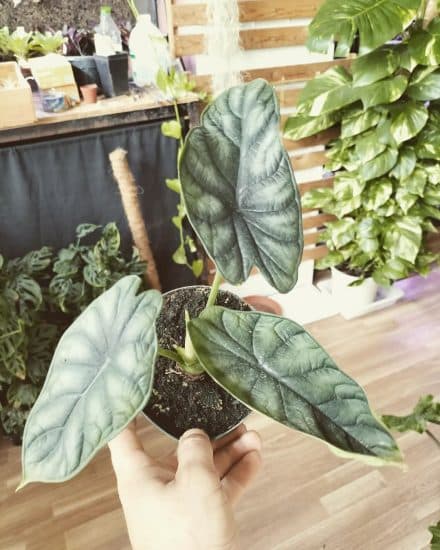
Sometimes your Alocasia Silver Dragon might be feeling a bit down, and its pale green leaves with dark green veins won’t look as perky as they should. It could be improper watering, a lack of sunlight, or even both.
First, check the soil’s moisture (give it a little poke), and if it’s too dry, give your plant a drink. If the soil feels soggy, you might be overwatering. Just let it dry out more between waterings.
Next up, sunlight.
Make sure your plant is basking in lovely east or north-facing light (nobody wants to be sunburnt, right?). Move it to a brighter spot or use a sheer curtain to filter any west or south exposure direct light.
Sun damage
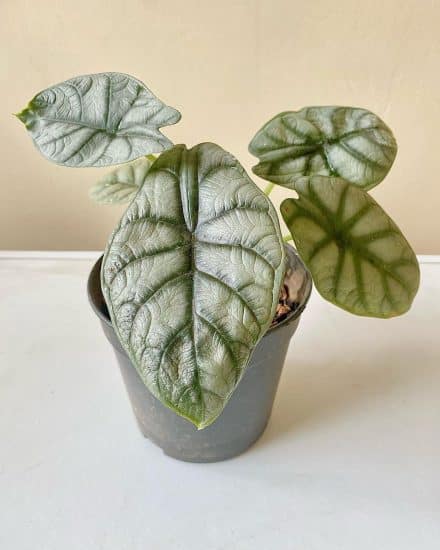
Speaking of sunburn, Alocasia Silver Dragons can suffer from sun damage, too. Those delicate leaves can get scorched if they’re exposed to direct sunlight, especially in the hot afternoon. Keep an eye out for yellowing, browning, or faded patches on the leaves (your plant’s way of saying, “Help, too much sun!”).
Here’s the fix: Gently move your Alocasia Silver Dragon plant to a spot where it gets light all day long. A sheer curtain can also be a lifesaver, filtering direct sunlight and shielding your plant from harsh rays. Before you know it, your Alocasia Silver Dragon will be on the mend, looking and feeling much happier!
Pests and diseases
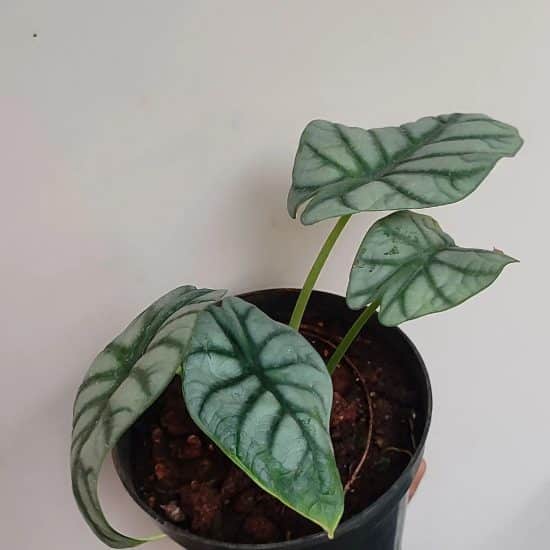
Pests
Alocasia plants like the Silver Dragon are usually good at keeping most mites away, thanks to their love for high humidity. But spider mites can still be a problem. These little bugs can damage your plant by feasting on its sap, leaving behind yellow and brown spots, and creating a web-like mess.
To check if your Alocasia Silver Dragon has some tiny uninvited guests, take a look at the leaves and stems for any reddish-brown mites and their delicate webs. Did you find any? Well, don’t worry, here’s what you can do:
- Gently wipe down the leaves and stems with a damp cloth, getting rid of any visible mites and webbing.
- Grab some neem oil or insecticidal soap — your plant will thank you. Apply it according to the label instructions so you can say goodbye to those mites for good. Oh, and don’t forget to spray both sides of the leaves and all parts of the stems, too.
Now, to keep these tiny troublemakers away in the future, ensure your Alocasia Silver Dragon has good airflow and decent air circulation (especially with high humidity).
Root rot
This issue comes up when your plant’s roots get too much moisture from overwatering or poor drainage. The result? Decaying roots that can eventually kill your beloved plant.
Keep an eye out for signs like yellowing or wilting leaves, a not-so-pleasant smell from the pot, and black or brown, mushy roots. If you think your Alocasia Silver Dragon has fallen victim to root rot, don’t panic — just follow these steps:
- Gently remove your plant from its pot and get a good look at the roots. If you see any that are affected, take sterilized scissors or pruning shears and snip them off. Remember to sterilize your tools before and after use — we don’t want any diseases spreading!
- Time for a fresh, well-draining potting mix! Add some perlite, pumice, or LECA to improve aeration and drainage, and then repot your plant in a clean pot with the new mix.
- Finally, show your Silver Dragon some H2O love — but sparingly! Make sure the pot has proper drainage holes to avoid any standing water.
To prevent future root rot, only water your Alocasia Silver Dragon when the top two inches of soil are dry (no sooner!) and avoid letting it sit in water. The right soil and pot with good drainage holes can make all the difference!
Conclusion
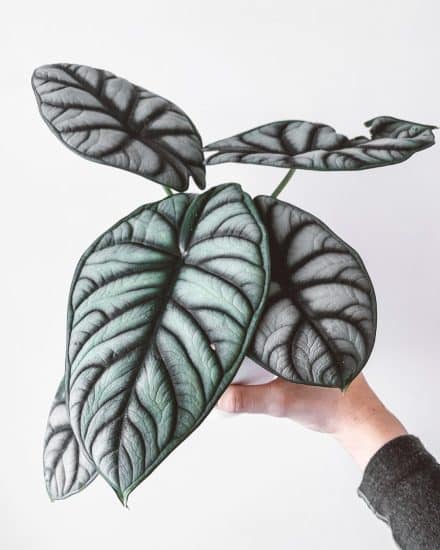
That’s a wrap on our Alocasia Silver Dragon care guide!
With proper care and attention, this enchanting plant will transform your indoor space into a magical forest filled with shimmering silver-green leaves. Follow our advice, and your Alocasia Silver Dragon will thrive.
Alocasia Silver Dragon care summary:
- Provide bright, indirect light, avoiding harsh direct sunlight that can cause leaf damage.
- Water when the top 50% of soil is dry, maintaining consistent moisture without causing root rot.
- Monitor temperature and humidity levels, aiming for 55 to 80°F (13 to 27°C) and 60%-80% humidity.
- Utilize a well-draining soil mix to prevent waterlogged roots, and consider repotting if needed.
- Propagate through corm separation during the growing season for new baby Silver Dragons.
Embrace the magical world of the Alocasia Silver Dragon, and before you know it, you’ll become a confident plant wizard, capable of nurturing this mystical plant to its full potential. If you found this guide helpful, please share it with fellow plant enthusiasts, and reach out to us with any questions.
Take care, and happy growing!
FAQ
Is Alocasia silver dragon rare?
Yes. Though it’s gaining attention among plant enthusiasts, this particular variety isn’t your everyday houseplant. Its unique, silvery foliage and intricate, dragon-scale-like pattern make it highly sought after by collectors and hobbyists alike. Given its exotic origins and captivating appearance, it’s no wonder this fabulous plant is a rare find.
Why is Alocasia Silver Dragon so expensive?
The Alocasia Silver Dragon’s higher-than-average cost primarily stems from its rarity and high demand. As we mentioned earlier, this plant is a rare beauty, which means it’s not as readily available as other more common houseplants. Paired with its increasing popularity among plant collectors and aficionados, demand for the Silver Dragon often outpaces supply, hence the steeper price.
What are the differences between Alocasia Silver Dragon vs Alocasia Dragon Scale?
Alocasia Silver Dragon flaunts stunning, silvery leaves adorned with intricate veining, giving it an almost ethereal appearance. The foliage has a matte texture with a delicate, powdery finish that shimmers when the light touches it. On the reverse side, the leaves boast a contrasting, deep maroon hue, adding a touch of drama to this eye-catching plant.
Alocasia Dragon Scale features rugged green leaves resembling the skin of a mythical beast. The intriguing raised texture of the leaves creates an embossed pattern, further highlighting the plant’s unique charm. Like its Silver Dragon counterpart, the Alocasia Dragon Scale also boasts an alluring purple underside to its leaves.
When it comes to nurturing a healthy plant, Alocasia Silver Dragon and Alocasia Dragon Scale are able to put their differences aside: care requirements are the same for each of these indoor plants.

